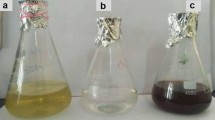Abstract
Because of the environmentally-friendly design and low cost, bio-mediated synthesis of nanoparticles has become popular in recent years. In this research, we utilized an aqueous extract of Prunus domestica (P. domestica) to produce silver nanoparticles (AgNPs). Different spectroscopic and microscopic studies have performed to characterize the as-produced AgNPs. The X-ray diffraction (XRD) findings showed the formation of crystalline face-centered cubic (fcc) NPs. Furthermore, the analysis of Fourier transform infrared (FT-IR) spectroscopy verified that the P. domestica leaf extract not only worked as a bioreducing agent and also capped the AgNP surface by serving as a stabilizing agent. The prepared AgNPs were tested for their antinociceptive (abdominal constriction response) activities. It was revealed that AgNPs suggestively reduced the chemically-persuaded nociception, which was equivalent to the effect of P. domestica extract. Further, these results conclude the use of P. domestica extract mediated AgNPs as antinociceptive agent for pain management in children.






Similar content being viewed by others
Change history
06 May 2020
The authors would like to add the first author as the co-corresponding author to the originally published article.
References
B. Moldovan, L. David, M. Achim, S. Clichici, and G. A. Filip (2016). J. Mol. Liquids. 221, 271–278.
R. Sriranjani, B. Srinithya, V. Vellingiri, P. Brindha, S. P. Anthony, A. Sivasubramanian, and M. S. Muthuraman (2016). J. Mol. Liquids. 220, 926–930.
P. Orlowski, M. Zmigrodzka, E. Tomaszewska, K. Ranoszek-Soliwoda, M. Czupryn, M. Antos-Bielska, J. Szemraj, G. Celichowski, J. Grobelny, and M. Krzyzowska (2018). Int. J. Nanomed. 13, 991.
K. Ranoszek-Soliwoda, E. Tomaszewska, K. Małek, G. Celichowski, P. Orlowski, M. Krzyzowska, and J. Grobelny (2019). Coll. Surf. B Biointerf. 117, 19–24.
M. J. Ahmed, G. Murtaza, A. Mehmood, and T. M. Bhatti (2015). Mater. Lett. 153, 10–13.
N. Ahmad, S. Bhatnagar, S. S. Ali, and R. Dutta (2015). Int. J. Nanomed. 10, 7019.
N. Shobha, N. Nanda, A. S. Giresha, P. Manjappa, K. Dharmappa, and B. Nagabhushana (2018). Mater. Sci. Eng. C. 97, 842–850.
H. Collier, L. Dinneen, C. A. Johnson, and C. Schneider (1968). Br J Pharmacol Chemother. 32, (2), 295–310.
P. Velusamy, J. Das, R. Pachaiappan, B. Vaseeharan, and K. Pandian (2015). Ind. Crops Prod. 66, 103–109.
N. L. Gavade, A. N. Kadam, M. B. Suwarnkar, V. P. Ghodake, and K. M. Garadkar (2015). Spectrochim. Acta, Part A 136, 953–960.
K. Rajaram, D. C. Aiswarya, and P. Sureshkumar (2015). Mater. Lett. 138, 251–254.
M. Nasrollahzadeh, S. M. Sajadi, and Y. Mirzaei (2016). J. Colloid Interface Sci. 468, 156–162.
V. K. Vidhu and D. Philip (2014). Spectrochim. Acta, Part A 117, 102–108.
S. S. Shankar, A. Rai, A. Ahmad, and M. Sastry (2004). J. Colloid Interface Sci. 275, 496–502.
G. Rajakumar and A. Abdul Rahuman (2012). Res. Vet. Sci. 93, 303–309.
H. Merskey, and N. Bogduk. 2nd ed. pp 210–3, (IASP Press, Seattle, 1994).
M. J. Millan (1999). Prog. Neurobiol. 57, 1–164.
S. P. Gawade (2012). J Pharmacol Pharmacother. 3, 348.
G. Bentley, S. Newton, and J. Starr (1981). Br J Pharmacol. 73, 325–332.
G. Bentley, S. Newton, and J. Starr (1983). Br J Pharmacol. 79, 125–134.
Gray, P. Spencer, and R. D. E. Sewell (1998). Br. J. Pharmacol. 124, 669–674.
A. M. Gray, D. M. Pache, and R. D. Sewell (1999). Eur. J. Pharmacol. 378, 161–168.
M. Sprintz, C. Benedetti, and M. Ferrari (2004). Minerva Anestesiol. 71, (7–8), 419–423.
S. B. Maddinedi, J. Sonamuthu, S. S. Yildiz, G. Han, Y. Cai, J. Gao, Q. Ni, and J. Yao (2018). J Photochem. Photobiol. B 186, 189–196.
S. B. Maddinedi (2017). Environ. Toxicol. Pharm. 53, 29–33.
S. B. Maddinedi, B. K. Mandal, and K. Kumar (2017). Environ. Toxicol. Pharm. 51, 23–29.
S. B. Maddinedi, B. K. Mandal, and S. K. Maddili (2017). J Photochem. Photobiol. B 167, 236–241.
S. B. Maddinedi, B. K. Mandal, and K. Kumar (2017). Environ. Toxicol. Pharm. 49, 131–136.
N. U. Islam, I. Khan, A. Rauf, N. Muhammad, M. Shahid, and M. R. Shah (2015). BMC Complement. Altern. Med. 15, 160.
N. U. Islam, K. Jalil, M. Shahid, A. Rauf, N. Muhammad, A. Khan, M. R. Shah, and M. A. Khan (2019). Arab. J. Chem. 12, 1–12.
N. U. Islam, K. Jalil, M. Shahid, N. Muhammad, and A. Rauf (2019). Arab. J. Chem. 12, 1–10.
M. Sprintz, E. Tasciotti, M. Allegri, A. Grattoni, L. C. Driver, and M. Ferrari (2011). Eur. J. Pain Suppl. 5, (S2), 317–322.
Author information
Authors and Affiliations
Corresponding author
Additional information
Publisher's Note
Springer Nature remains neutral with regard to jurisdictional claims in published maps and institutional affiliations.
Rights and permissions
About this article
Cite this article
Wang, W., Lu, Z. & Yan, H. P. domestica Extract Mediated Silver Nanoparticles and their Antinociceptive Activity for Pain Management in Children. J Clust Sci 32, 85–90 (2021). https://doi.org/10.1007/s10876-020-01764-0
Received:
Published:
Issue Date:
DOI: https://doi.org/10.1007/s10876-020-01764-0




